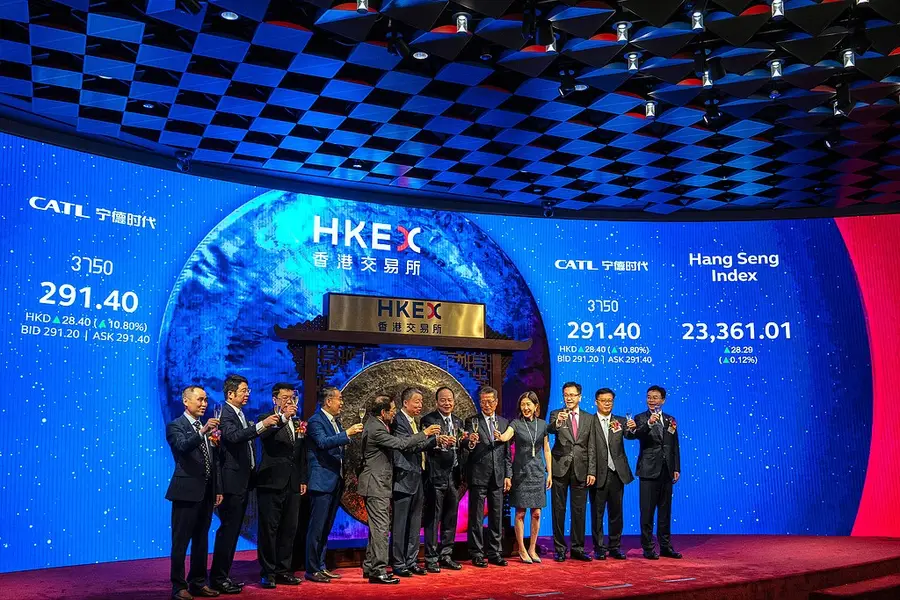Hong Kong IPOs explode in first half as China Inc. abandons New York

Hong Kong listings by 44 companies raised $13.6 billion in the first six months of 2025, accounting for a quarter of the world’s total IPO fundraising
Key Takeaways:
- Hong Kong led the world in IPOs in the first half of the year with $13.6 billion in new fundraising, as New York IPOs by Chinese companies raised just $841 million
- Hong Kong has taken steps to lure Chinese companies to the city, as they avoid New York over U.S.-China frictions and face difficulties listing in Shanghai and Shenzhen
By Doug Young
Hong Kong became the world’s leading IPO market in the first half of 2025, accounting for a quarter of global fundraising from new listings, as money-hungry Chinese firms raced to list in the city after a quiet period over the previous three years. Second listings in Hong Kong by Shanghai- and Shenzhen-listed Chinese firms were a major factor behind Hong Kong’s boom, as such companies sought to raise both cash and their global profiles.
At the same time, many Chinese firms that might have previously chosen to list in New York largely abandoned that route this year amid heightened geopolitical tensions between the U.S. and China. Only one Chinese company made a major new U.S. listing in the first half of 2025, as milk tea chain Chagee (CHA.US) raised more than $400 million in its April IPO. And even that was offset by announcement of a privatization bid for electric vehicle (EV) maker Zeekr (ZK.US), which raised a similar $441 million with a New York listing just a year ago.
If those trends continue, which looks likely, 2025 would mark the best year for Hong Kong IPOs since 2021, and would be the second-highest year for IPO fundraising year in the last decade.
Forty-four IPOs by companies in Hong Kong raised a combined HK$107.1 billion ($13.6 billion) in the first half of the year, equal to seven times the amount raised in the first half of 2024, PwC said in a report this week. In a similar report issued in June, Ernst & Young said that Hong Kong IPOs accounted for 24% of all fundraising from new listings worldwide in the first half of the year.
Both reports said the momentum in Hong Kong was likely to continue into the second half of the year, with PwC forecasting companies would raise more than $200 billion with new listings on the Hong Kong Stock Exchange for all 2025.
While Hong Kong boomed, E&Y observed that fundraising by Chinese companies through U.S. IPOs tumbled by 62% to $841 million, even as the number of new listings rose by 44% to 36. That showed that mega-IPOs from China, typically worth $100 million or more, are increasingly rare in the U.S., and most deals still going to New York are pint-sized offerings worth $20 million or less.
Reflecting the growing preference for Hong Kong, which dates back over the last two years, China’s securities regulator approved 30 new listings by Chinese companies seeking to list on the Hong Kong Stock Exchange in the first half of the year. That was more than double the 12 companies approved to list on the Nasdaq by the China Securities Regulatory Commission (CSRC), which must approve all such new overseas listings.
The CSRC’s pipeline of pending overseas listing applications looks similar in terms of the preference for Hong Kong. Of the 183 applications currently under consideration by the regulator, 126 are from companies hoping to list in Hong Kong, while just 42 are seeking to list on the Nasdaq. And none of the pending Nasdaq applicants has hired a top-tier investment bank, indicating most or all will likely raise $20 million or less.
All about policy
Several factors are behind the Hong Kong boom, nearly all of them policy-related. The biggest factor driving Chinese companies from the U.S. is increasingly tense relations between Beijing and Washington, with some American politicians even suggesting that all Chinese companies should be delisted from U.S. stock exchanges.
China is playing a role as well due to its concerns that large amounts of personal and customer data held by Chinese companies could become accessible to the U.S. government if those companies list in New York. Such concerns led to the forced delisting of leading ride-sharing company DiDi Global from the New York Stock Exchange in 2021.
Similar concerns were also likely a factor in the uncertain fate of a pending blockbuster listing by online fast fashion sensation Shein. The company originally aimed to list in New York, but abandoned that plan after running into political headwinds from Washington. Shein later shifted its sights to a London IPO. But it abandoned that plan last month, reportedly over objections from the CSRC, which would like the company to list in Hong Kong.
China has also fueled the rush of companies to Hong Kong by limiting the number of new listings on its domestic A-share markets in Shanghai and Shenzhen, in a bid to support those markets. Reflecting the weaker sentiment among domestic investors, the Shanghai Composite Index is up just 6% this year, well behind a 23% rise for Hong Kong’s benchmark Hang Seng Index.
Hong Kong has seized on U.S. and Chinese political frictions, as well as China’s data security concerns and limits on new IPOs in Shanghai and Shenzhen, by taking steps to make its stock market more attractive to new Chinese listing candidates. The Hong Kong Stock Exchange launched a Technology Enterprises Channel in May, making it easier for early-stage specialist tech and biotech companies to list. And last October it published another new policy making it easier for Chinese companies with A-share listings in Shanghai or Shenzhen to make second IPOs in Hong Kong, which is more open to international investors.
The largest Hong Kong IPO in the first half of the year came from one such second listing, as EV battery giant Contemporary Amperex Technology Co. Ltd. (3750.HK; 300750.SZ), or CATL, raised about $4.6 billion through a Hong Kong IPO to complement its older listing in Shenzhen.
While Chagee stood out from its peers by listing in the U.S., the first half of 2025 was also notable for IPOs by several of the company’s larger rivals in Hong Kong, led by the $440 million IPO by leading premium tea chain Mixue (2097.HK).
Gold listings were also popular in the first half of the year as prices for the precious metal soared to record highs. That helped Jilong Gold (6693.HK) to raise $419 million in its February IPO. The same gold fever could also spark another mega listing in the second half, following Zijin Mining’s (2899.HK) filing of a preliminary prospectus this week as it gets set to spin off and separately list its Zijin Gold International unit.
To subscribe to Bamboo Works weekly free newsletter, click here





